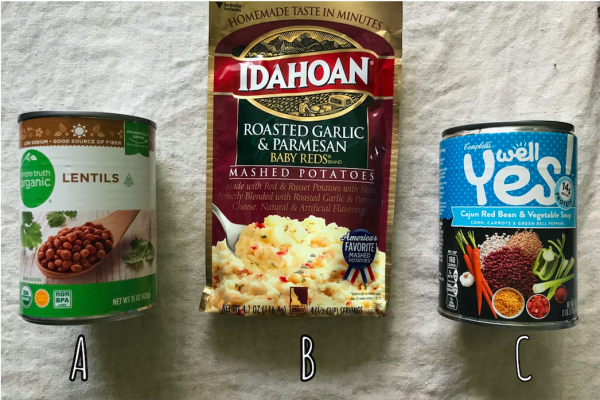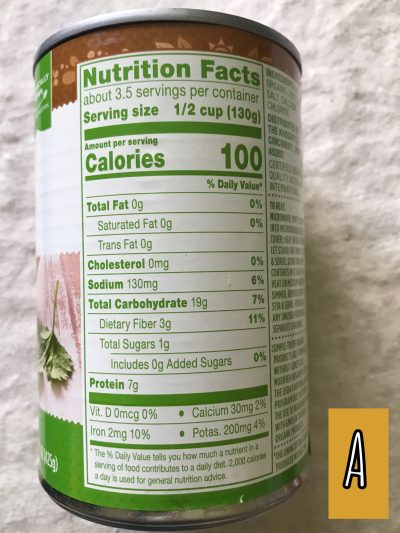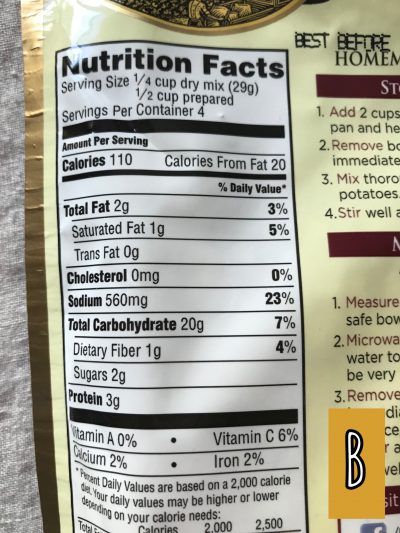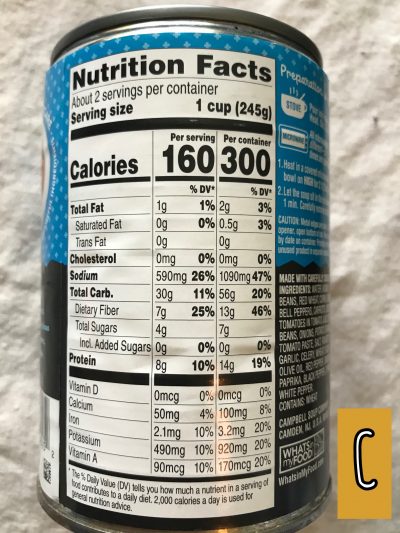What is sodium?
Table salt–the most common form of salt–is a combination of sodium and chloride. It is used to preserve food and enhance flavor. Overeating foods with salt can increase your risk for high blood pressure and other diseases.
How much sodium am I supposed to eat?
The Dietary Guidelines for Americans recommends no more than 2,300 milligrams (mg), or about 1 teaspoon, a day of sodium for most adults. [1] Despite this, Americans tend to eat more than 3,400 milligrams of sodium each day! [2]
Look at the label
The nutrition facts label tells you how much sodium is in that food per serving. It also tells you what percentage the sodium makes up of the recommended maximum for the day (2300 mg). 5% daily value or less of sodium per serving is considered low, and 20% daily value or more of sodium per serving is considered high.[3]
As you eat throughout the day, add up the percentages. Make sure you don’t go over 100%. For those who should get no more than 1,500 mg a day, try not to go over 65%.
Where can sodium be found?
Did you know that more than 70% of the sodium Americans eat comes from packaged, prepared, and food purchased away from home (think fast food, restaurants, gas station deli, etc. ) — not the saltshaker?
About half of the sodium consumed by Americans comes from the following foods. The items that have been bolded are areas where you might not have expected sodium to be found:
- Breads and rolls
- Pizza
- Sandwiches (such as hamburgers, hot dogs, and submarine sandwiches)
- Cold cuts and cured meats (such as deli and packaged ham and turkey)
- Soups
- Burritos and tacos
- Snack foods (such as chips, crackers, microwave popcorn, and pretzels)
- Chicken (includes processed chicken)
- Cheese (includes processed cheese)
- Egg dishes and omelets
Other areas where sodium hides are:
- Sauces, like soy sauce, hot sauce, enchilada sauce, salsa, and alfredo sauce
- Canned food, like beans
- Salad dressings
Make sure to check the nutrition facts label to see the percentage of your daily value for sodium for each of these items.
Activity
Look at the last packaged food item you ate, whether it’s a granola bar wrapper or a handful of cheese crackers from a box. Find the sodium section on the nutrition facts label and look at the percentage of your daily value of sodium that one serving had.
Was it more or less than 5%? Was it more or less than 20%? If it was high, are there any low-sodium versions of your snack that you could have next time?
Test your skills now
Which of the following would be the lowest sodium option for dinner? Read the nutrition facts label and see what the percentage daily value for sodium is. Bonus points: check out the serving size at the top of the label. Are you surprised by how much sodium is in that serving size?




Answer: A!
- Option A has 130 mg, or 6% of the daily value of sodium. A food item must be 5% the daily value to be “low” in sodium. Option A is very close to this.
- Option B has 560 mg sodium, or 23% of the daily value of sodium. It is over the 20% mark, so this option is technically “high” in sodium.
- Option C has the new nutrition facts label that includes the percent daily value per serving and per the entire container. Option C has the highest amount of sodium with 590 mg, or 26% of the percent daily value. Option C is also over the 20% mark so it is “high” in sodium. Eating the whole can of soup has a whopping 1060 mg of sodium! That’s half your sodium allowance for the whole day!
- Still, each of these items can be fit into a healthy diet. For example, if you choose to eat the soup, maybe cut your sodium intake elsewhere throughout the day.
Written by Taylor Newman, Ph.D. Candidate | Edited by Laurel Sanville, MS, RDN, LD
Original photo sources